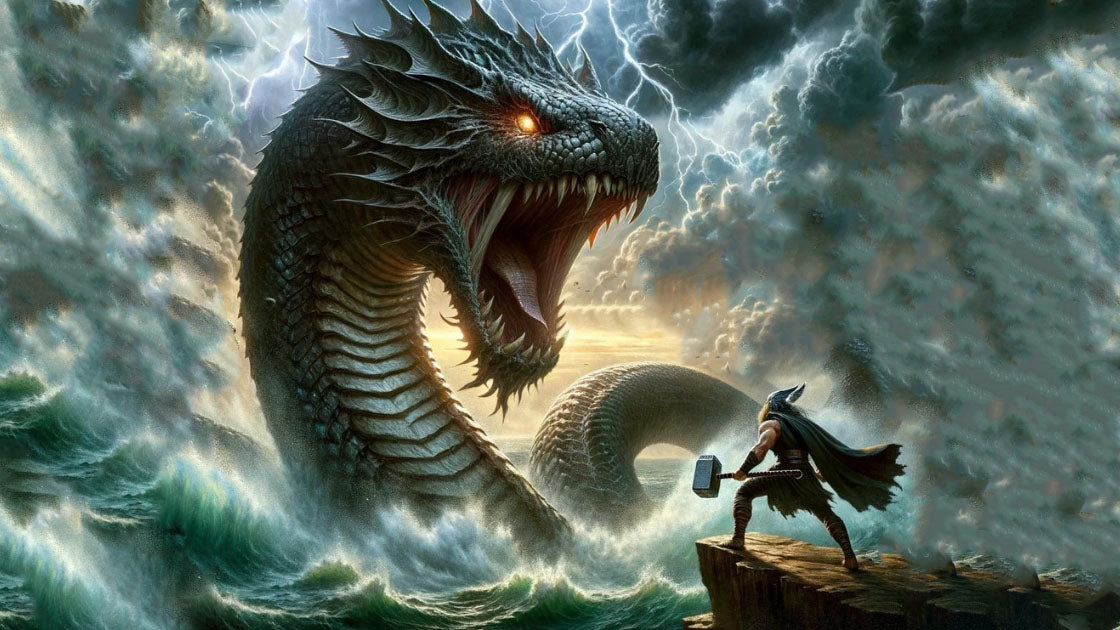Jörmungandr: The Untold Story of The Epic Sea Serpent Destined to Battle Thor in Norse Mythology
Jörmungandr, the iconic sea serpent nemesis of Thor in Norse mythology, plays a pivotal yet overlooked role that deserves greater recognition. This massive serpent encircles the world and is fated to kill Thor during Ragnarök in an unforgettable mythic duel.
Introduction to Jörmungandr, the World Serpent
In Norse legends, few rivalries surpass the cosmic feud between Thor and Jörmungandr. While Thor enjoys mainstream popularity nowadays, Jörmungandr remains obscure despite his integral role. As one of Loki’s monstrous children, this gigantic serpent was exiled by Odin to the ocean surrounding Midgard. Unrestrained in the seas, Jörmungandr grew large enough to encircle the entire world and grasp his own tail. His Homeric epithet “Midgard Serpent” encapsulates his colossal size and global habitat.
The Symbolic Meaning Behind Jörmungandr
Beyond his physical enormity, Jörmungandr symbolizes powerful mythic concepts in Norse cosmology. His ouroboros form – a serpent devouring its own tail – represents the cyclic nature of life, passing and rebirth. His encircling of the world symbolizes both infinity and the precarious oceans bounding Midgard. As Loki’s progeny, Jörmungandr embodies the chaos and cunning associated with his notorious father. Most significantly, Jörmungandr's fated mutual defeat with Thor carries symbolic weight – the old order must fall to bring forth the new world.
Jörmungandr’s Pivotal Role in Norse Ragnarök
As a central figure in the apocalyptic Norse legend of Ragnarök, Jörmungandr is destined to kill Thor in their mythic duel. According to prophecy, Jörmungandr’s fury triggers natural disasters, enabling demonic enemies to siege Asgard. Arriving on the battlefield, Jörmungandr blankets the skies with venom before battling Thor. He ultimately delivers a fatal bite to Thor, who perishes after just nine steps despite slaying the serpent. This mutual destruction brings tragic yet fitting closure to their rivalry, allowing the old world order to dissolve.
The First Clash Between Thor and Jörmungandr
Thor’s legendary feud with Jörmungandr begins under deceptive circumstances. Traveling in Jötunheim with Loki, Thor visits the hall of Utgarda-Loki and is challenged to prove his might. Attempting to lift Utgarda-Loki’s cat, Thor struggles vainly as it arches upward out of reach. Afterwards, Utgarda-Loki reveals this cat was actually the disguised Jörmungandr, whom Thor lifted high enough to uncoil his tail. Furious at this trickery, Thor swings his hammer at Utgarda-Loki, who disappears and evades the blow. This earliest encounter establishes simmering tensions between Thor and the serpent.
The Fateful Fishing Trip Where Thor Hooks Jörmungandr
Their second meeting escalates these hostilities further. In the “Prose Edda,” Thor suggests fishing with the giant Hymir to redeem himself after the cat-lifting incident. But in the “Poetic Edda,” Thor needs a cauldron from Hymir to brew ale. Either way, Thor ends up fishing and manages to hook Jörmungandr, who thrashes violently in response. Jörmungandr spits burning venom into Thor’s face as the god hauls him from the depths. But before Thor can attack with his hammer, Hymir cuts the line, allowing Jörmungandr to sink back beneath the waves. This fateful fishing trip marks the last encounter between Thor and Jörmungandr until their legendary clash at Ragnarök.
Contrasting Depictions of Jörmungandr Across Pop Culture
Despite his important mythological role, Jörmungandr appears infrequently in modern pop culture compared to well-known Norse gods like Thor. Marvel's films omit him entirely from Thor: Ragnarok, though his siblings feature prominently. However, some works do portray the serpent notably. The TV series Vikings shows the mystic Floki communes with the wise Jörmungandr. And the God of War games showcase an epic boss battle between Kratos and the colossal sea serpent. While overall underutilized in pop culture, these examples demonstrate Jörmungandr's potential.
The Pronunciation and Meaning of Jörmungandr’s Ominous Name
Jörmungandr’s name contains immense symbolic weight in Old Norse. Pronounced “YOR-mun-gan-der,” it translates approximately to “huge monster.” The first part “jör” means huge or mighty, while “mun” means monster and “gandr” means staff. Combined, these elements create the foreboding name “mighty monster staff,” encapsulating how this mythical serpent grew to encircle the earth. Jörmungandr’s name perfectly captures his otherworldly enormity and cosmic significance in Norse legends.
The Destined Adversarial Roles of Jörmungandr and Thor
As fated adversaries, Jörmungandr and Thor assume opposing mythic roles that drive their cosmic conflict. Jörmungandr embodies primordial chaos and annihilation, seeking to overwhelm the ordered cosmos. Thor represents the principle of divine order itself as a defender of gods and men. Their mythic purposes form mirror images – Jörmungandr must instigate destruction while Thor tries to prevent it. This eternal clash between chaos and order takes symbolic form in their adversarial relationship, which can only end in mutual destruction.
Why Jörmungandr Deserves More Recognition Among Norse Legends
For his paramount importance in Norse cosmology and his epic mythology with Thor, Jörmungandr merits more attention and study. His rich symbolism, key role in Ragnarök, and fatal battle with Thor should captivate imaginative minds. Yet this captivating giant sea serpent remains obscure compared to more established Norse deities. Just as Greek monsters like Typhon that challenged Zeus gained lasting fame, Jörmungandr deserves recognition for nearly overthrowing the Norse pantheon during Ragnarök. His fascinating mythology should claim a greater share of pop culture interest.
Conclusion
In Norse legend, no figure entwines more closely with Thor’s fate than Jörmungandr, yet this epic serpent suffers from undue obscurity. For his intricate mythic symbolism, pivotal role in the apocalyptic Ragnarök, and climactic mutual slaying of Thor, Jörmungandr deserves far greater mainstream popularity. His story contains imaginative depth equal to any Greek or Norse deity. Next time you encounter Thor in popular media, remember the iconic sea serpent lurking just beneath the surface of ancient Norse mythology.






Leave a comment